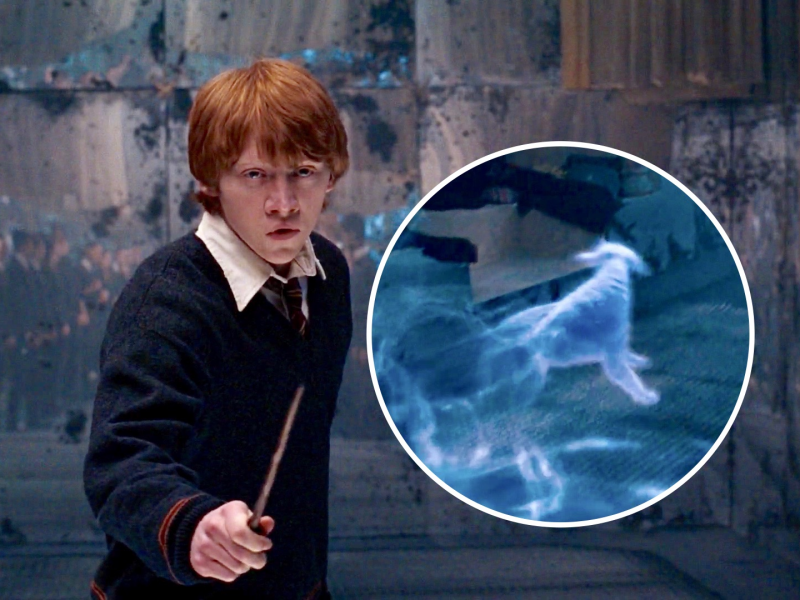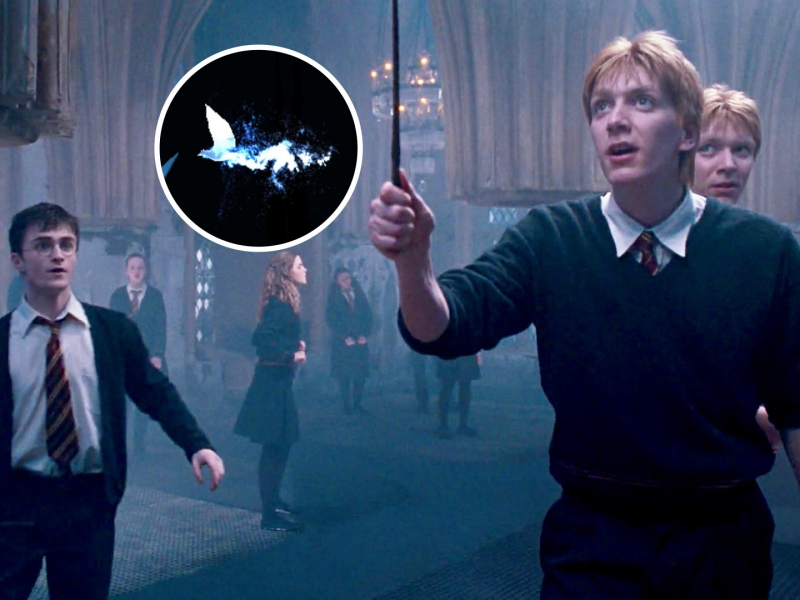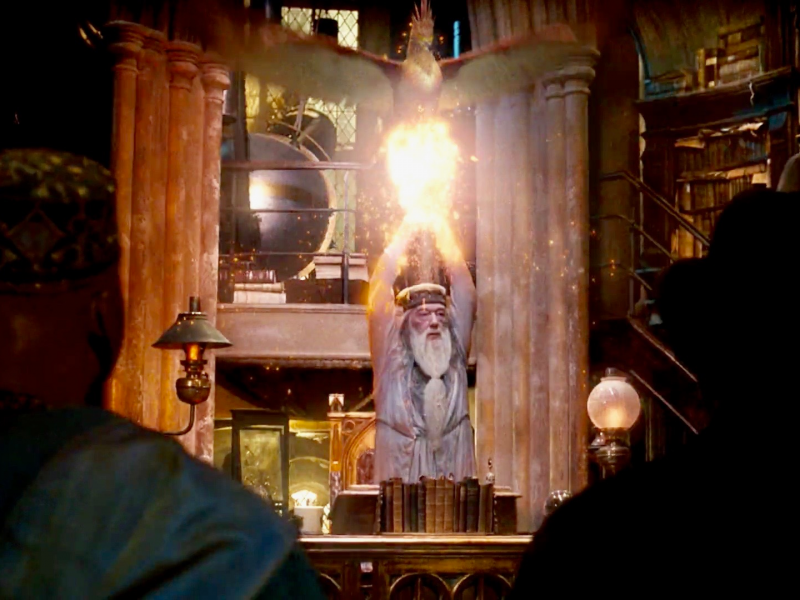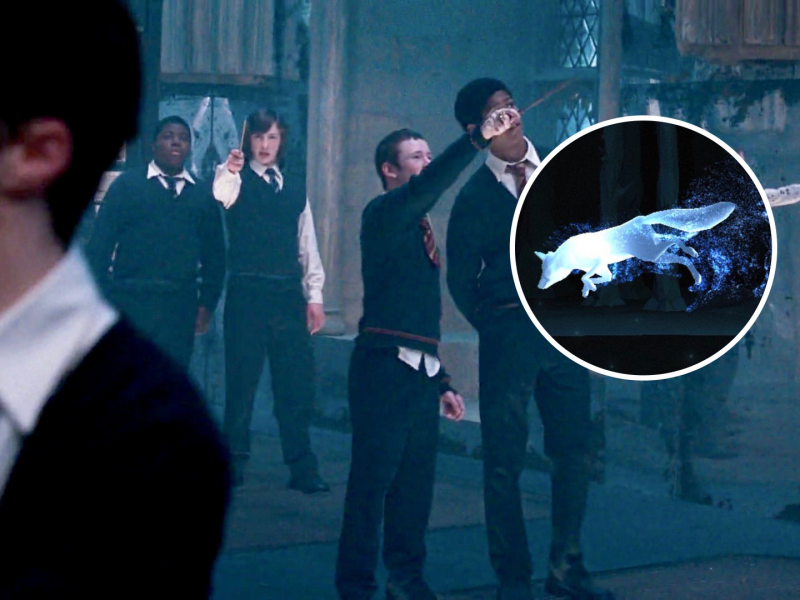- In the “Harry Potter” universe, the Patronus charm is among the most mysterious, revealing, and difficult types of magic to master.
- When done correctly, it takes the form of a silvery-white animal, individually suited to the witch or wizard who cast it.
- Here are the Patronus charms of all 22 characters known to have mastered the spell – plus J.K. Rowling.
- Visit INSIDER’s homepage for more stories.
In J.K. Rowling’s growing arsenal of Wizarding World magic (including potions, spells, charms, and plenty of fantastic beasts), the Patronus charm remains a fan favorite.
It’s among the most mysterious, revealing, and difficult types of magic to master, especially in its most powerful form. When done correctly, the defensive spell takes the form of a silvery-white animal, individually suited to the witch or wizard who cast it.
Twenty-two characters in the “Harry Potter” universe are known to have mastered it. Here are all the shapes their Patronus charms take – plus Rowling’s herself.
Harry Potter’s Patronus is a stag, like his father.

Harry’s ability to produce a powerful, corporeal Patronus at age 13 – under the guidance of his third year Defense Against the Dark Arts professor, Remus Lupin – is noted throughout the series as a mark of his impressive talent.
"The majority of witches and wizards are unable to produce Patronuses and to do so is generally considered a mark of superior magical ability," Rowling wrote on Pottermore.
The Patronus of Harry's mother, Lily Evans, took the form of a doe.

Lily is never seen casting a Patronus in the "Harry Potter" books or films, but Rowling has noted her ability to produce a corporeal doe Patronus on multiple occasions.
Severus Snape's Patronus was also a doe, which symbolized his love for Lily.

Snape's doe Patronus reveals his one true motivation throughout Harry's life: to protect the child of the woman he loved.
In "Deathly Hallows," Snape also uses his Patronus to help Harry on his quest to find Voldemort's horcruxes; a Patronus charm can be used to send messages, and Harry seems to subconsciously recognize the doe as an extension of his mother, allowing him to trust it.
According to Rowling, Snape was the only Death Eater who could conjure a Patronus charm at all.
"A Patronus is used against things that the Death Eaters generally generate, or fight alongside," she wrote in 2007. "They would not need Patronuses."
"He was careful not to use the talking Patronus means of communication with [either Death Eaters or Order of the Phoenix members]," she added. "This was not difficult, as his particular job within the Order, ie, as spy, meant that sending a Patronus to any of them might have given away his true allegiance."
James Potter's stag Patronus may have been different when he was younger.

Harry's father's Patronus was the same as his Animagus - a form he adopted at Hogwarts, which earned him the nickname "Prongs."
However, Rowling has said that Lily's Patronus being a doe and James' Patronus being a stag is not a coincidence.
"The Patronus often mutates to take the image of the love of one's life (because they so often become the 'happy thought' that generates a Patronus)," she wrote of the couple in 2007.
It's more likely that James' Patronus morphed to match Lily's when they fell in love, rather than the other way around; since Snape had known Lily since childhood and his Patronus matched hers, it seems reasonable to assume that Lily's Patronus had been a doe all along.
Hermione Granger's Patronus takes the form of an otter.

Rowling has said that she gave Hermione an otter Patronus because it's her favorite animal; the author admits she sees much of herself in the young witch, including shared "insecurity and a great fear of failure."
Fans have also noted that Hermione's Patronus may have been hinting at her feelings for Ron. The surname Weasley is similar to "weasel," which is from the same family (Mustelidae) as the otter.
Ron Weasley's is a Jack Russell Terrier.

In 2005, two years before Ron conjured a Patronus onscreen in "Order of the Phoenix," Rowling revealed that his charm would take the shape of a Jack Russell Terrier.
"Ron's Patronus is a small dog, like a Jack Russell, and that's a really sentimental choice, because we've got a Jack Russell," she wrote. "He's insane."
Fans have also noted that the Jack Russell Terrier is a breed of dog known for its love of chasing otters - the Patronus form of Ron's future wife, Hermione.
Ginny Weasley casts a Patronus in the shape of a horse.

Ginny's Patronus is never described in the books, but we see her successfully produce a Patronus in the shape of a horse in the "Order of the Phoenix" film.
As noted on Pottermore, the shape of Ginny's Patronus has a small connection to that of her future husband's. When Harry first sees his corporeal stag Patronus across the lake in "Prisoner of Azkaban," he thinks it looks like a horse.
Fred and George Weasley have the same Patronus shape: A magpie.

Rowling revealed on Twitter that the Weasley twins both cast Patronus charms shaped like a magpie, which is a type of bird.
"We have a saying about them in the UK, 'one for sorrow, two for joy,' as you might know," she wrote. "Plus, they're talkative thieves."
Arthur Weasley's is a weasel.

Arthur conjures his Patronus in "Deathly Hallows" in order to send a message to Harry, Ron, and Hermione.
"Harry drew his wand again and spun round to see a silver Patronus soar through the drawing-room window and land upon the floor in front of them, where it solidified into the weasel that spoke with the voice of Ron's father," the book reads.
Albus Dumbledore's is a phoenix.

In "Goblet of Fire," Harry watches Dumbledore conjure a Patronus in order to send a message.
"He raised his wand into the air and pointed it in the direction of Hagrid's cabin," the book reads. "Harry saw something silvery dart out of it and streak away through the trees like a ghostly bird."
The Patronus shape was later confirmed to be a Phoenix on Pottermore: "It can be no surprise that Dumbledore had an affinity with this particular creature, given that his own animal companion was an enigmatic and loyal phoenix, Fawkes."
According to Pottermore, Dumbledore's Patronus takes one of the most uncommon forms.
Aberforth Dumbledore's is a goat.

In "Deathly Hallows," Harry conjures his Patronus in Hogsmeade, which is recognized by multiple Death Eaters.
Aberforth then summons his own Patronus in an attempt to convince the dark wizards that they really saw a goat, not a stag.
Luna Lovegood's Patronus is a hare.

After filming "Order of the Phoenix," in which Luna's Patronus is revealed as a hare, Rowling personally gifted actress Evanna Lynch with a hare charm to wear as an earring.
Remus Lupin's Patronus takes the form of a wolf — but he prefers to produce a non-corporeal shape.

According to the character's biography on Pottermore - written by Rowling herself - Lupin's Patronus takes the form of "an ordinary wolf, not a werewolf."
"Wolves are family-orientated and non-aggressive, but Remus dislikes the form of his Patronus, which is a constant reminder of his affliction," Rowling writes. "Everything wolfish disgusts him, and he often produces a non-corporeal Patronus deliberately, especially when others are watching."
The hare Patronus cast by Nymphadora Tonks changed shape to match her future husband's.

Tonks originally conjured a Patronus in the shape of a hare, according to Pottermore.
But in "Half-Blood Prince," Harry watches her produce "an immense silvery four-legged creature." Snape tells Harry that her Patronus had changed, and Harry later tells Lupin that it "looked big, and it had four legs."
When he realizes that Tonks had fallen in love with Lupin, he understands that the shape of her Patronus had changed to match his and become a wolf.
According to Rowling herself, Tonks' Patronus shape had changed permanently: "Your Patronus only changes if it's eternal love, unchanging - part of you forever."
Minerva McGonagall's Patronus takes the same shape as her Animagus form: A tabby cat.

In "Deathly Hallows," Harry watches McGonagall conjure three separate corporeal Patronus charms in order to send messages: "She marched towards the door, and as she did so she raised her wand. From the tip burst three silver cats with spectacle markings around their eyes."
Dolores Umbridge also produces a Patronus in the shape of a cat.

While Umbridge is an objectively hateful woman, she is also a skilled witch. As Rowling noted on Pottermore, she is one of few Dark Magic enthusiasts who's capable of producing a Patronus.
"While there is a widespread and justified belief that a wizard who is not pure of heart cannot produce a successful Patronus... a rare few witches and wizards of questionable morals have succeeded in producing the Charm," Rowling wrote. "Dolores Umbridge, for example, is able to conjure a cat Patronus to protect herself from Dementors."
Seamus Finnigan's Patronus takes the shape of a fox.

Seamus was able to conjure a full Patronus in a Dumbledore's Army meeting, but it disappeared very quickly, only revealing itself to be "something hairy."
Seamus' Patronus is revealed to be a fox during the Battle of Hogwarts: "And then a silver hare, a boar, and a fox soared past Harry, Ron, and Hermione's heads: The dementors fell back before the creatures' approach. Three more people had arrived out of the darkness to stand beside them, their wands outstretched, continuing to cast their Patronuses: Luna, Ernie, and Seamus."
Ernie Macmillan's is a boar.

The Hufflepuff managed to conjure a powerful boar Patronus during the Battle of Hogwarts.
Cho Chang's is a swan.

Cho managed to produce a swan Patronus during a Dumbledore's Army meeting.
Kingsley Shacklebolt's is a lynx.

Kingsley's Patronus arrives as a warning in "Deathly Hallows," when the Ministry is overthrown by Death Eaters: "Graceful and gleaming, the lynx landed lightly in the middle of the astonished dancers," the book reads.
"Heads turned, as those nearest it froze, absurdly, in mid-dance. Then the Patronus's mouth opened wide and it spoke in the loud, deep, slow voice of Kingsley Shacklebolt."
As for the "Fantastic Beasts" hero Newt Scamander — only time will tell.

When a fan asked Rowling on Twitter if she would reveal the shape of Newt's Patronus, Rowling refused.
"Big spoiler," she wrote.
One can assume, however, that Newt has mastered the charm - otherwise the shape it takes wouldn't need to be a secret.
BONUS: J.K. Rowling revealed that her Patronus was a pine marten, but changed to a heron.

When Pottermore revealed its brand new Patronus test in 2016, which Rowling wrote herself, she told fans on Twitter that she had taken it twice.
"I took the Pottermore test (which I wrote) ages ago when it was a work in progress and got a pine marten Patronus. I was happy, because my fondness for weaselly creatures is well documented," she wrote on Twitter.
"However, when we finalized the Pottermore test last week I took it again and found that it had changed (which, as we know, can happen). My new Patronus has personal associations and I like it even better," she revealed.
... so as far as I'm concerned, the @pottermore test works! Here's my Patronus... pic.twitter.com/xnjKfjGMx4
— J.K. Rowling (@jk_rowling) September 22, 2016
"It's a heron," she further clarified.
Visit INSIDER's homepage for more.










